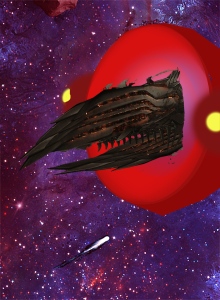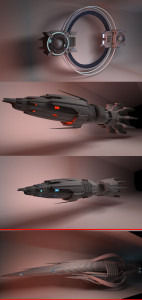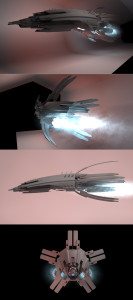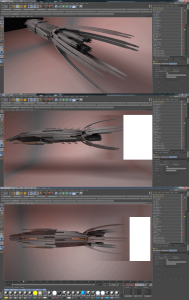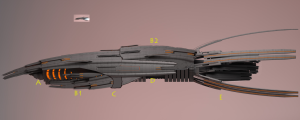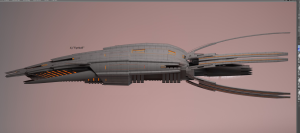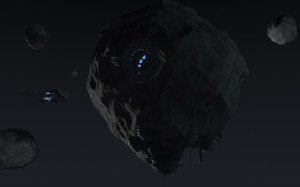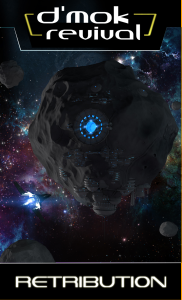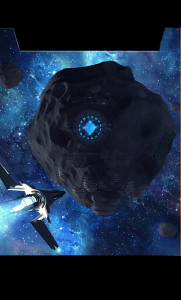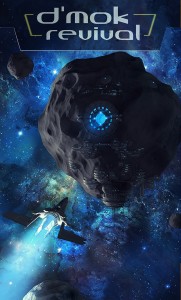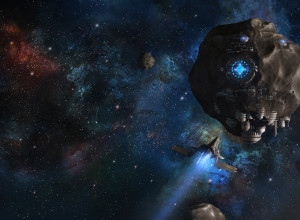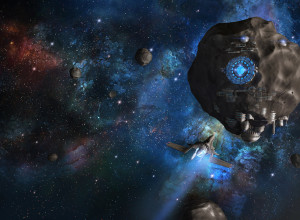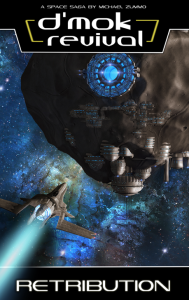I’ve been asked how the original 286,000 word manuscript compared to the final 286,000 word Nukari Invasion Trilogy. The truth is: it evolved a great deal! Entire segments were removed or reconstructed, characters were added, new storylines injected, and timelines on various events shifted. This is due, in part, to an amazing editor (Arlene Robinson), reviews from family and friends, and my own growth as a writer.
Keep in mind, before D’mok Revival was a novel it was originally intended to be a role playing game. Hundreds of pages of backstory and a gameplay system created the foundation for a future computer/console RPG.
The original manuscript was my virtual play through of the original 24 source modules. Sure, the order seemed to make great sense at the time, but it could have happened very differently, after all, that’s what a game designer intends when creating modules for an expansive universe. You want the game players to create their version of it through their decisions, etc.
For those concerned about spoilers, the next sections are clearly labeled with specific books and the changes made to them. Read only as far as you’d like to!
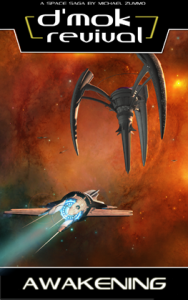
Book 1: Awakening
The first book was the closest to the original manuscript. My editor at the time helped with some grammatical aspects and some restructuring. Note: it wasn’t Arlene Robinson for this book—long story why not. I corrected that mistake moving forward. He also said Rhysus had far too much power from the outset, always came up with a new ability to get himself out of a situation, and never seemed like he was honestly in danger–ever.
Now, anyone who’s watched Japanese Anime and sentai shows (Sailormoon, Dragonball Z, etc.) knows this is EXACTLY how characters develop and new abilities emerge. Great burst of emotion, near defeat, with a win from a new power. Nevertheless, the books were targeted at a North American audience, and toning things down didn’t seem so bad. So how and when Rhysus’ abilities emerged was restructured. He’s much less powerful and far less in control from start to finish.
His other major suggestion was to have Toriko’s “professor arc” resolve in book one. He said “something needs to be resolved in your first book.” And so, the professor, who was saved originally in book three, DIES in book one. How’s that for a change?
Those were the main things the first editor contributed. On to more changes that I imposed!
Originally there was no prolog. As I neared the end of writing the massive manuscript, I felt it needed more of an opener. I thought of this in terms of the opening CG of a video game. I wanted something that got the readers up-to-speed on the story and helped expose the mindset of Rhysus. In the end, I really loved the dark and disturbed result.
The first chapter, which introduced Osuto and Rhysus’ abilities remained mostly intact. My original editor suggested I cut everything from the prolog through Rhysus’ arrival at the Trading Post. He was concerned the first part was too slow and would lose people. I kept it in because I wanted to provide more context for who Rhysus was and what he was doing and not just drop people into the Trading Post.
The initial experience on the trading post remained the same.
My editor originally suggested removing the introduction of Menla on Aeun. He said she was a red herring and didn’t have a purpose. She does show up in the epilog of book 2, and comes back in book 4. I, of course, had an idea of her future use and wanted to keep her introduction in so readers could go back and go “Oh my gosh, she’s right there–on Aeun–the WHOLE TIME!” 😉
The section with picking up Toriko was radically overhauled. The original concept had Daleron diverting Rhysus’ teleport to the underground versions and interrogating him, accusing him of kidnapping Toriko (who had gone missing). It turns out she went into hiding herself and left cyber-caches that, after all were recovered, would lead to her. It provided more background about her legendary status on their version of the Internet as Master Tecra (alluded to in book 2), and her reputation for cyber-caching, a phenomena where they use the internet to find coordinates of cool things, then hunt down the caches at those coordinates. It’s actually based on GEO-Caching, a real thing in the USA. The parts found in the caches were assembled into a robot that led Daleron and Rhysus to her. They trekked through more of the underground to bring down the teleportation system. There was also a communications grid that could phase in and out (don’t ask) they needed to destroy before invading the Nukari base found in the lower versions of the Murai Dome.
This whole thing was reworked to start with Toriko already in the company of Daleron. Spark also led Rhysus through the lower versions to her. Don’t worry, a future book about Toriko will bring back more exploration of the lower versions of the Murai Dome on Tericn!
Toriko’s physical stature changed a bit. The original editor said he didn’t envision her as more overweight (as she was listed), so I had Ujaku make a comment about her weight loss. She’s not, and never will be, skinny. I want her to be a healthy weight, if not slightly over-weight.
Nothing changed when Toriko and Rhysus saved Ujaku from the mercenaries, nor when they went to the graveyard of ships. The chapters that cover the initial flight of their ship and crash remained the same.
The section that captured Rhysus’ chase of Allia through her caverns was shortened, but otherwise remained largely unchanged. The segment where Rhysus goes to Abunai and finds Naijen was the same.
When Allia falls sick with radiation poisoning, Eyani originally said the medical facilities were not up and going on the Trading Post yet, so she sends him to an ally of hers off-station. This relic store owner sends the team (minus Allia) on a mission to a dessert world to capture a creature that can siphon the radiation out of her (crazy right)?
This evolved into Eyani being able to help them directly with medical facilities, which you’d expect a massive station to have available. Instead, she asks a favor (the first of two). They do go to the desert world, but for a totally different reason. The adventure in the sand ruins was shortened, and refocused on the statue. The rest of that was in the original manuscript.
Crystal legacies remained the same. But the final mission to the sister science station was embellished. I brought back the professor, who had led the Nukari to that station, and created a backstory for him to explain how and why that was possible. To my surprise, the professor was killed when the Nukari attempted to escape. Rhysus’ awakening with respect to his responsibilities and abilities also pop here.
The other major change was Bob’s role. Originally he was just comic relief. As people read the original manuscript people LOVED him. Seriously, LOVED him. Given Bob was in every system an idea sprung to mind: what if Bob was much more than he seemed? He transformed in my mind from a helper system to a powerful AI that ran the station and much of Eden too. He became a main character moving forward.
Another interesting dynamic was the human fallibility Rhysus displayed with how he handled the death of the professor. This would come back to haunt him.
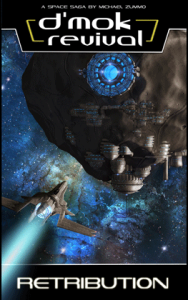
Book 2: Retribution
I learned so much from book one’s release. There were insightful reviews, direct emails, Facebook messages, and more that helped me understand where the first book was strong, and where improvement could be found. I’m thankful for the feedback!
One of the big issues from book one was: Where were the Nukari, exactly? Some criticized it was too “adventur-ie” and the main bad guys “just ran a company on one of the planets.” The original intention was the main character didn’t know much about what was going on, nor where the Nukari were, you the reader shouldn’t know either. That didn’t seem to work. In the end, people were looking for more action, more direct conflict with the Nukari, etc.
Believe it or not, the Nukari Beasts (or Combinates as they were originally called) were mentioned towards the end of book 2 defending a Dyson Sphere. It was this same chapter where Anrik’s group was first introduced. When I began reworking book 2, I saw this as an immediate opportunity to build upon.
The prolog was actually a chapter that appeared earlier in book 2 that was intended to tease what was to come with Katen. With a few tweaks I infused information about the Nukari Beasts, Anrik’s team, and ultimately Mencari’s team into it. Suddenly it became a great primer for all the players the reader would encounter in book 2. Boom! It was segmented out and placed as the prolog.
At that point I created the entire thread about the Nukari Beasts. I had a short story I wrote to understand dynamics in my universe where Rhysus ran into Decreta (who was more human looking back then) in a bar. Soon both were called away, then found themselves meeting in combat in space directly after (yet somehow they didn’t recognize each other—don’t ask). I liked the meet-in-a-bar concept, and saw a change to use it on the first world where the Nukari Beasts attacked. However, I used it to introduce Anrik instead. Funny how things change-up.
The resolution to Toriko’s professor’s death was also added. It gave me a chance to really give a spine to Toriko. Everything that happens to her concerning the death of the professor, including getting the new outfit and ship from Maro, was added in the rewrite. Personally, I think it added amazing depth to Toriko (and Maro).
The chapters with Nikko, Cogeni, and his mother were in the original manuscript. Nikko was far more passive in her first incarnation. She also hid the fact she had abilities from Cogeni. I think she was so weak because, of all the characters, I didn’t understand who she was at the time. By the time I starting re-editing book 2, she became far clearer to me. After all, I had already written the fourth manuscript where (never mind—no spoilers)… Just believe me, I clearly understood her now. So, I evolved her in book 2. She was more confident, capable, an equal. This was a great change!
The various leads, and exploration of Luon was all in the original manuscript. I created more interesting descriptions of the characters and main locations. I had to rewrite the problem Zuri had with Allia to make it more plausible, in addition to Allia pushing herself to manifest her abilities. Otherwise, the essence of those chapters stayed the same—including Seigie’s “cure.”
Turf War was the reworking of what used to be about the Nukari beasts defense of a Nukari controlled Dyson Sphere (think Star Trek The Next Generation here). In the new version, Eden was tracking the beasts and led Rhysus’ team to them. With this I wrote an entirely new battle scene, really digging into the specifics of each character’s experience.
The next section covered finding Cerna. This originally came much later in book 3. However, adding Cerna now added an interesting element to book 2. Here the group ran back into the relic store owner from the first book. He was an ancient “Dark Lord” from Cerna’s world. Seeing I took him out of the first book, he needed to get pulled from the second. I also changed the group landing on an asteroid and finding a shrine with information, to more of a gateway shrine. I also made the shield around the Cosmic Temple activate to force the characters inside. The experience inside the template was vastly shortened. The original version had them exploring more inside the temple finding traps left by Dark Lords, messages from Cerna’s faction, etc. It will be useful for a future video game version, but not for a succinct, focused reading experience.
I also embellished the memory crystal records inside the temple, and the technology that kept her alive. Originally Cerna was in a leaf-like tomb, which had to be cut into to find her. The descriptions around this tomb were sparse, and honestly not inspired. So, I reworked the entire thing.
There was also a side quest to find her glaive after freeing her. Also, before going back to the asteroid base she had Rhysus take her down to her world to see the aftermath. There was even a segment where she reanimated a prisoner to free him. Again, unnecessary. Cut.
The mission to attack the “big Nukari ship” remained mostly the same from the original. There were more Nomads involved, which were simplified down to one core representative in the final story. There were so many characters in my books. I learned to really only name ones that mattered.
Once Katen was a part of the group, the final showdown with the Nukari Beasts could take place. Foul 359 was an entire new piece, and the big crescendo for book 2. As you may have read, I worked in many references, homages, puns, etc. from popular science fiction and video games into the story. Foul 359 is an anagram for Wolf 359 from Star Trek The Next Generation… It’s where the Borg with Locutus (Picard turned Borg) attacked the Federation. I thought it would be fun to play with in my story.
A few things happened in this new ending that helped the future books. Mainly, Anrik had been captured. The Nukari would now have lots of information about the Human Coalition. Katen saved the day, which helped show his allegiance. Decreta was also captured, which is how the original Dyson Sphere version went down.
In the end, the rewrite also had Mencari finally accepting his wife and son’s demise and taking off the ring he so tightly clung to up to this point.
The other notable aspect that changed in book 2’s rewrite was Mini-T. Before she was a helper system, much like the original concept for Bob. Instead, she rapidly evolved into an advanced AI. This continues through the series. Wait until you see what happens in book 4… But I digress.
On, one final addition… The boy with the green eyes! Now, he plays a big role after book 4… So I wanted to introduce the concept of him here. See, it’s a good thing I didn’t release all these books yet. I had the chance to evolve things and make it seem like it was always planned this way. 😉
The epilog was originally a part of the final chapter. It just worked better isolated since it was from the perspective of the Nukari and not Rhysus or his group.

Book 3: Descension
The prolog was brand new. It was so much fun to write! I LOVED envisioning Kajlit’ga. She’s such a beast, and yet, I found she had redeeming qualities. I didn’t intend that, but that’s what I saw and thought, so that’s what I typed. It gave her depth, which was fantastic.
The pocket work concept was in the original manuscript. However the entire set of chapters came much earlier in book 2. It now led book 3. This was interesting as it introduced another unique power to the D’mok literary universe (and possibly future video game). 😉
I added more descriptions of the moon, and create a color caste system for the Aloan defenders and High Dome Guards. Those encountered with ability stifling powers, and mindseers was all new. I thought it added a lot of color to Aloan society, and really helped show how a world of super-beings would be run.
I cleaned up the interactions in the museum, specifically with accessing the ancient D’mar section. I went into more detail about Jeyla, Siana, and Raitr (as they show back up in book 4, and I understood them better now). I also tweaked D’gorra’s presence, and the final experience on the moon leading to D’gorra’s power grab. The rest stayed the same.
The Nukari trap that springs on Ruul really evolved nicely. The world of Ruul became a space junk wasteland, and with it a whole new set of dynamics and scenery. I love how it transformed! As such, I worked on making the trek through Ruul appropriate given the new terrain and threats.
As Rhysus was searching for Toriko’s group, I changed how they found one another. Originally Naijen did a massive attack that ripped up through the ground, and Rhysus and company flew down. It was far too convenient. I took the idea of Naijen creating massive attacks, and rewrote the scenario so something he did still led to the catastrophe going on across Ruul. But I redid how Rhysus found Toriko’s group. In the new version the Nukari were also more of a threat.
The original version also had Rhysus with a mental break, which was far too cliché for me now. One of his over-powered attacks led to a near collapse of the tunnels, leading to a combination of Seigie and Speru’s abilities to keep the roof from collapsing. The new version is better.
Moonbase Alpha covered the interrogation of the captured Nukari commander and the Nukari beast from the end of book 2. Specifically, Katen used his abilities to Mindwalk the beast. This was in the original manuscript, but was removed from the third book. My editor, Arlene, said it just interrupted the flow of things. I totally agreed, but wanted to make sure people could still experience the mindwalk. That’s why I created a self-contained short story of the removed mindwalk section.
The rest of the moonbase alpha and K’pec chapters remained the same.
The mission where Kiyanna took the group to Keros had some tightening, but remained the same for the most part.
Beast Hollow was refined to be more plausible given the characters, their knowledge, and skills of the group at that point. Decreta’s space travel ability was back up and usable, Bob and Mini-T were able to hack systems in the new version, and I wanted to show off more of the Nukari genetic experiments and beasts. I also involved the Nomad fleet in helping to destroy the Nukari space station. In the end, I think it was more action packed than the original. Osuto’s overuse of his abilities was also in the original manuscript.
I punched up the drama for Paradise Lost (playing off of Milton’s story talking about “Eden”). You also get to find out who the boy with the green eyes is. Again, none of this history existed in the story until the rewrite. I even came to understand myself more about Eisah’s mother.
Legends never die dramatically changed. For starters, in the revised version Kiyanna had a major role in designing the attack on the Nukari. She really shined! What she planned, and how she executed it was not in the original script. I LOVED the rewrite!
In the original version Cerna unleashes Sabereth around her homeworld. Why she did this it didn’t say. I theorized she did it so if the Nukari or other unwelcomed people came back to her nebula they wouldn’t get the power of the Cosmic Temple. Regardless, in the rewrite she does not free the cosmic entity. However, this opens the door for what’s going to happen in a future book. Again, can’t mention more about that yet! Sorry!
The attack on the Nukari Command, now called the Nukari Colonial Authority, was very different. The original version had three specific missions presented in the book. They took place at the same time, so the reader experienced one at a time, but saw references to help understand the timeline. While interesting, and GREAT for a video game experience (think the end of Final Fantasy 6), the book version needed one clear thread to follow. So, I simplified it down to one view of the battle.
The big scene with the Leviathan remained the same from the original manuscript. I was always proud of that particular scene. It will be awesome in a future movie… Haha.
I reworked Dane’s character to be a bit less obtuse with the situation too.
In the end, I added a small part with Eisah in the dream sequence. The rest of that chapter remained the same, including the cliff hanger surprise! I was very proud of the way the original manuscript ended and kept it!
I wrote a new epilog from Kajlit’ga’s perspective. You saw her final rise to power, and what the Nukari were doing in the aftermath of the allied attack on them. The reader will know the story is far from over.
And there you have it! How the original manuscript evolved into the current Nukari Invasion Trilogy!




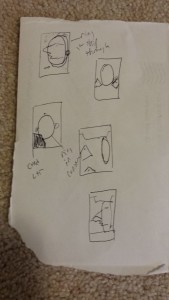
![tumblr_mcpl92H8Bj1rxphab[1]](http://dmokrevival.com/wp/wp-content/uploads/2014/12/tumblr_mcpl92H8Bj1rxphab1-300x160.jpg)
